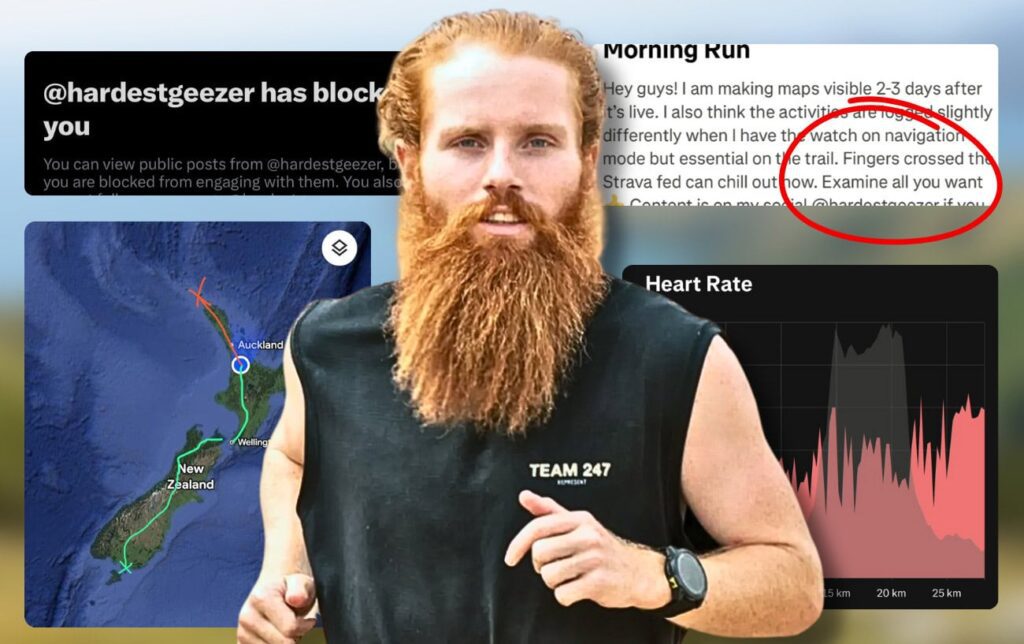Russ Cook, known as the Hardest Geezer, is an ultrarunner and social media influencer revered for pushing the boundaries of human endurance. With a significant online following, Cook has become a leading figure in the world of extreme running and fitness.
After claiming to be the first person to run the full length of Africa, a year-long journey he completed in April 2024, Cook has set his sights on a new ambitious goal: running the entire length of New Zealand. This journey spans from the southern tip of the South Island to Cape Reinga in the north, drawing significant attention on platforms like Strava, where he shares daily updates with his 1.2 million Instagram followers, over 280,000 TikTok fans, and 338,000 followers on X.
The Business of Extreme Runfluencing
Cook’s journey is not solely a personal challenge; it represents a lucrative brand partnership fueled by his extensive social media clout. His rise has seen him gain substantial influence, being ranked as the 71st largest athletic account on Instagram globally, as reported by Inflact.com.
During his Africa run, Cook’s daily updates and compelling narratives facilitated his transformation into a mainstream figure, garnering widespread coverage from various reputable media outlets. This earned media has catapulted his public profile, enabling him to monetize his social media presence, with creators of his stature reportedly earning between $10,000 and $25,000 per sponsored Instagram post.
Moreover, Cook is represented by Chartwell Speakers, an agency that includes high-profile personalities. This representation indicates Cook’s growing stature and marketability in the influencer arena. His current New Zealand venture is a promotional campaign supported by 100% Pure New Zealand, the country’s tourism board, illustrating the commercial aspect of his adventures.
A Different Kind of Challenge
Contrasting with his more spontaneous and communal Africa run, the New Zealand project has taken on a noticeably more polished and commercial tone. While his earlier journey involved frequent interactions with fellow runners and raw updates, his New Zealand posts primarily highlight scenic landscapes, often tagged as advertisements due to platform disclosure regulations.
This shift from an exploratory spirit to a transactional one has raised eyebrows among his followers, who are accustomed to the unfiltered updates from his previous endeavors. Cook’s persona is built around relentless endurance, with celebratory moments like completing a 100-kilometer day with a beer chugging spectacle. However, there is growing concern about the authenticity of his current mission, especially since the posts now feel more like contractual obligations rather than genuine adventures.
The Data Delay
Initially, Cook began sharing detailed metrics from his runs using a Garmin Enduro 2 watch, a highly specialized device for extreme endurance activities. However, as his journey progressed, discrepancies arose. Followers began to notice missing GPS tracking and metrics that aligned poorly with the terrain he was covering. Cook attributed early syncing issues to Garmin’s navigation mode, but his explanations have not placated concerned followers.
As scrutiny increased, Cook’s Strava posts began to lack detail, omitting specific metrics that had previously been available. His responsiveness to queries about the missing data shifted from engaging to dismissive, with some users reporting that they were blocked when they pressed for transparency.
A Surge of Speculation
This reduction in transparency has led to mounting speculation about the legitimacy of Cook’s endeavors. Followers have pointed out anomalies in heart rate data that do not correlate with his reported level of exertion on steep terrains. Observations about sudden shifts in metrics and unusual stride lengths have further fueled this discourse.
Such inconsistencies, coupled with Cook’s refusal to adequately address them, have raised concerns about the authenticity of his journey. Many in the world of endurance running, driven by data, expect a level of accountability that Cook has yet to provide. This has created a divide between his loyal supporters and those who are increasingly skeptical.
Trust and Receipts
While Cook’s narrative may ultimately position him as a resilient athlete completing another monumental challenge, the data discrepancies have complicated this image. The intricacies of ultrarunning campaigns rely heavily on trust, especially when they are commercially backed.
To maintain his audience and continued sponsorship opportunities, providing transparent proof of his journey is essential. In a space where metrics hold significant value, the lack of detail surrounding his current endeavor raises questions about his commitment and the authenticity of his accomplishments.
Should Cook wish to retain the goodwill generated from his previous ventures, he might need to offer more than promotional content. Presenting verifiable data from his New Zealand trek could go a long way in reassuring fans and critics alike about his authenticity.
In conclusion, the evolution of Russ Cook’s brand, from a daring ultrarunner to a prominent influencer, has brought both remarkable success and significant scrutiny. As he continues his challenging journey through New Zealand, the balance between personal achievement and commercial obligation will inevitably shape his narrative in the eyes of his followers and the broader running community.
